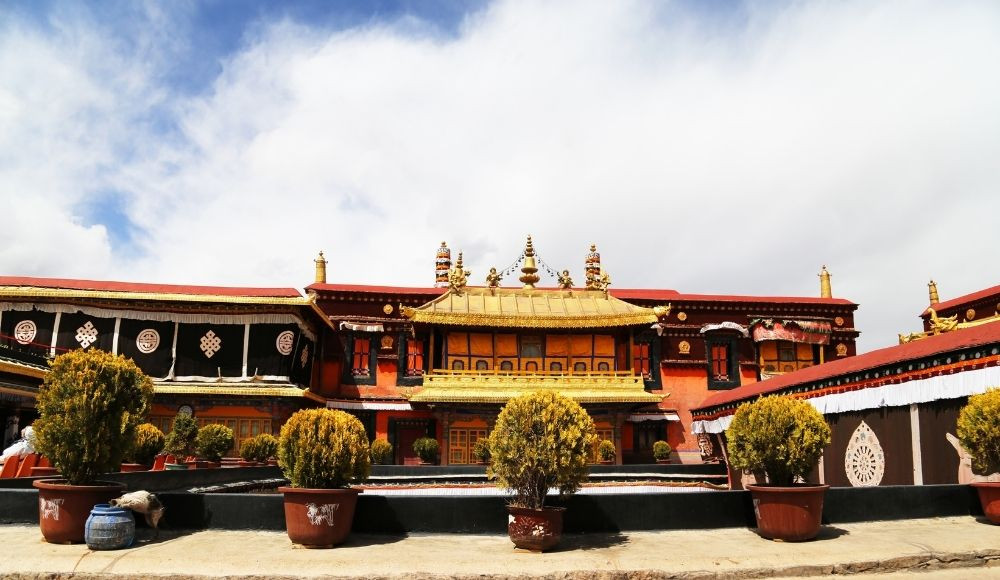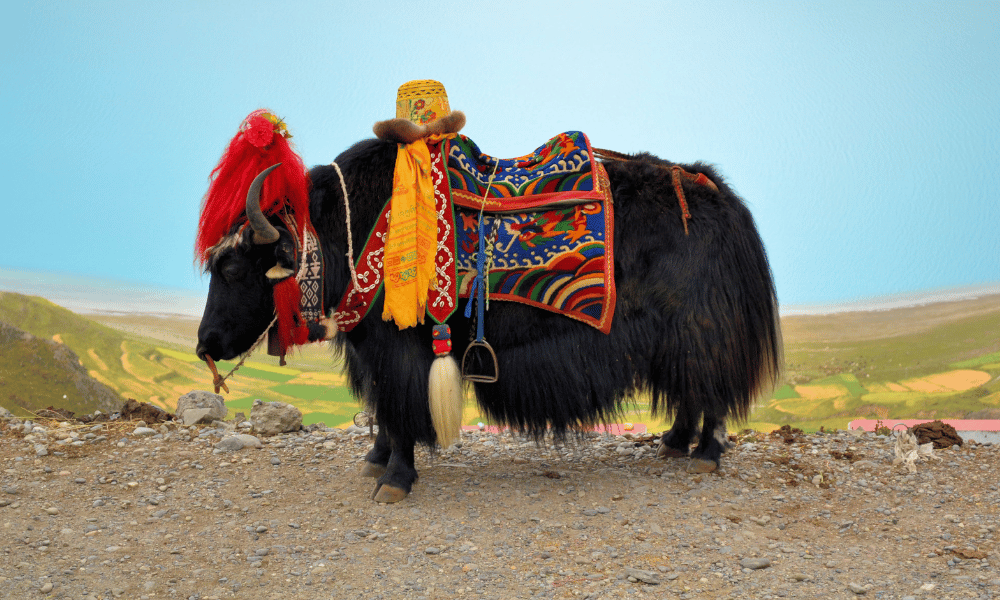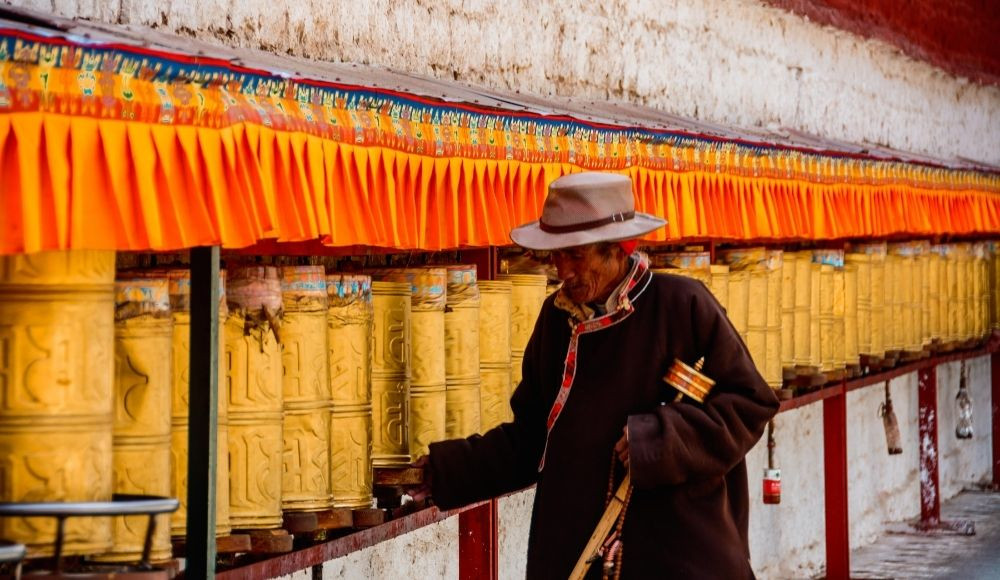Lhasa Everest Base Camp Tour
Trip Facts
Trip Highlights
- Magnificent landmarks throughout the trip including the winter palace of Dalai lama.
- Explore the unique landscapes, rich culture, and spiritual significance.
- Road trip to the base camp of Mount Everest.
- Unique geography along with mountain deserts, spectacular lakes and high passes.
- Tour the holy ground of Lhasa, Tibet.
Trip Overview
Our 8 days Tibet tour is an exclusive road trip to the north Everest Base Camp that starts from Lhasa, the capital of Tibet. This tour is perfect if you are adventurous and want to explore the holy ground of Lhasa and a comfortable tour to the Everest Base camp (North side of Mount Everest) from Lhasa. Your journey starts from the holy land of Lhasa, now where is Lhasa you may ask? Lhasa simply translates to (Lha, the ‘abode of the Gods’) also known as the Forbidden City located at the border of China and Nepal inside Tibet which is a part of China. Lhasa is a hidden gem with mind-blowing history, isolated and untouched by the world. Get a first-hand travel experience to Lhasa through this Lhasa Everest base camp tour. During your tour, you will gain new travel experiences to new environments along with unforgettable memories. Once you are in the holy land you will notice perfectly preserved monuments and ancient treasures. The vibrant prayer flags mark its territory along with a peaceful atmosphere.
Tibet is the spiritual center of one of the great religions - Tibetan Buddhism and home to several natural beauties. This tour provides you with an insight into great religion, its tradition, ancient landmarks, history and pure beauty. Besides the traditional beauty, you will also get to see the phenomenal geography of this place and a golden opportunity to visit the base camp of Everest (North Face). This tour is an absolute opportunity to explore the spectacular landmarks of Tibet which includes the arid mountain desert, jaw-dropping turquoise lakes, the highest monastery on earth and a smooth road trip to the Everest base camp. Lhasa is the only place from where you can visit Everest base camp via road and witness the beauty of the tallest mountain on earth - Mt. Everest 8848 m without having to walk for weeks.
Tibet is the birthplace of one of the great spiritual leaders, his holiness Dalai Lama, meaning you will get to see hundreds of monasteries, and religious landmarks throughout your tour that display authentic Tibetan identity. Lhasa welcomes people from all walks of their lives whether you are seeking inner peace, going on a spiritual journey, or adventure in the highlands. Lhasa is the starting point for many one-of-a-kind trips and religious journeys such as Kailash Mansarovar Yatra via Lhasa. Along with the natural beauty, Tibet proudly boasts its majestic ancient architecture, mostly religious structures such as Potala Palace, nunneries, Buddhist administrative buildings, and other significant places. Get an insight into the lives of locals and their way of living, their strong faith and holiness through this journey to Lhasa, China.
Lhasa Everest Base Camp Tour Attractions
Tibet is one of the top destinations if you are looking for something historical infused with a deep sense of spirituality. Throughout your tour, you will visit and explore the monuments and get a deep insight into their history, religious significance, and their charm. Apart from the monuments you will notice endless mountain chains and picturesque landscapes. You can easily spot the major landmarks as they are beautifully decorated and quite stand out. You will notice vibrant prayer flags and the sharp smell of traditional incense as you visit the monuments. Inside most of the monuments, there are precious figurines, murals, Thangkas, and tombs of great personals. If you are interested in architecture you will surely get your mind blown. Taking pictures, and videos are strictly prohibited inside the monasteries, temples and nunnery so capture the beauty within yourself rather than in your cameras.
Potala Palace - The winter palace of his holiness Dalai Lama.
Potala Palace built in the 7th century is commonly known as the winter palace of the Dalai Lama. It’s an incredible landmark located within Lhasa, Tibet at an amazing altitude of 3,700 m, making the Potala the highest palace in the world. The majestic palace is enclosed with massive walls, gates, and a spectacular view of the entire Lhasa city. The palace is a great example of authentic Tibetan architecture and a great display of the traditional arts in the form of Thangkas, ancient murals, statues and cultural artifacts.
Inside the Potala Palace you will see luxurious decorations along with precious statues and ancient antiques. Potala palace has great historical value with the symbol of Tibetan Buddhism and its central role in the traditional administration of Tibet. The palace comprises 1000 rooms, tombs of 8 Dalai Lamas, hundreds of shrines, and statues made from precious metal and jewels. The palace is divided into two sections - the red palace and the white palace which you can separate as it is colored in two distinguished colours. The red building is the residence of the Dalai Lama and the white part is the administrative part.
Jokhang Temple - The house of Buddha.
Jokhang Temple is considered to be the ‘’spiritual heart of the city’’ and is one of the most sacred temples in Tibet. It was built by Tubo King Srongtse Gampo in 652 to marry the Nepali princess Bhirkuti. The temple is made out of wood, stone and precious metals featuring the Tibetan Buddhist style influenced by Indian Vhiara design and Nepal. You will notice shiny gilded bronze tiles, figurines, and decorated pinnacles. The temple houses the statue from the time when Shakyamuni Buddha lived.
Shakyamuni is a historical personality known as Siddhartha Gautam, the son of Suddhodana and his queen Maya, who became the Buddha upon achieving enlightenment. Princess Bhrikuti brought several statues from Nepal to Tibet as dowry when she got married which now is inside the temple, giving it extreme religious values. Inside the temple people offer water, lights, flowers, incense and tormas (sculptures made out of butter and flour).
Barkhor Street - The holy road.
Barkhor Street is the ancient round street surrounding the Jokhang Temple. It is called the holy road as it surrounds the sacred temple and many pilgrims. You will see people walking in a clockwise direction doing their ritual and you will also notice people body-length by body-length Kora (Circumambulation). The way they express their devotion will give you an insight into their religious seriousness. This place shows the original outlook of Lhasa. Besides the religious side, there are numerous shops on both sides and hundreds of floating stands on every corner. Prayer wheels, traditional Tibetan dresses called ‘’Chuba’’, various handmade jewelry and Thangkas are some of the things you can get here. It is a great place to explore and also get local food as many small local restaurants provide an authentic taste of Lhasa. This place is full of a religious atmosphere with a hint of exotic articles.
Drepung Monastery - The Rice Heap.
Drepung Monastery is the largest of all Tibetan monasteries and is located on the Gambo Utse mountain just five kilometers from the western suburb of Lhasa. Drepung Monastery is called the ‘’rice Heap’’ which is a reference to the white building dotting the hills. It was first founded in 1416 by Jamyang Choge Tashi Palden, one of the disciples of Tsongkhapa. The monastery was named after the sacred abode in south India of Sri Dhanyakataka. It is one of the ‘’Great Three’’ Gelug University Gompas (Monasteries) of Tibet. The monastery houses thousands of monks who devote their lives to learning the teaching and doctrines of Buddhism. Besides being an important religious structure it is a spectacular view of the surrounding as well. From here you get to see the snow-capped hills all along. This beautiful monastery used to be the residence of the Dalai Lama before the construction of the Potala Palace was completed therefore it holds significant religious values.
Sera Monastery - The hail monastery.
The Sera monastery is one of the‘’ Great Three’’ monastic universities in Tibet. The word Sera is attributed to the ancient legend that during the construction of the monastery, the hill behind was covered with wild roses, or ‘’Sera’’ in Tibetan. It was founded in 1419 by the great Lama Jamchen Choeje Shakya Yeshe, one of the principal disciples of Lama Tsong Khapa. The monastery is composed of two colleges, Sera Jey and Sera Mey. Sera Monastery provides basic education in Buddhist religion to approach the Buddhist doctrines; a practice particular to the Gelukpa or yellow hat sect of Tibetan Buddhism. Every weekday in the courtyard of this monastery monks debate with each other, usually in a pair. They debate in their learning of the doctrines and it happens like this; one standing asks questions and the other sitting on the ground answers. And if the one standing claps their hands it's a crack meaning the answer is wrong. They both get turns to ask one another.
Yamdrok Lake - The Jade Lake of Tibet.
Yamdrok Tso (Lake in Tibetan) lies on the southern edge of the Nyenchen Tanglha Mountains, lake Yamdrok or Yumtso is a beautiful turquoise-blue freshwater lake in Nagarze, Shannan. Yamdrok is the largest lake at the northern foothills of the Himalayas as well as one of the great three holy lakes in Tibet, along with the Namtso and Manasarovar lakes. It is located around 114 km to the southwest of Lhasa at an elevation of 4,441m above sea level. One of the most attractive sights of the land of snow. It is also called the jade lake of Tibet because of its natural turquoise colour that can be seen from a distance. To reach the lake you will cross the Kamba La pass which is the vantage point of the lake where you will get a panoramic view of the lake and its surrounding hills. Besides the lake, you get to see animals such as Tibetan mastiffs and yaks beautifully decorated on the edge of the lake so that you can take photos with the animals along with gorgeous dropbacks of the lake.
Palcho Monastery - The auspicious wheel of joy.
Palcho Monastery is a phenomenal landmark of Tibetan art history. The most striking monastery is a symbol of Gyantse i.e. the Bodui Dagoba (Tibetan name Pelkhor Choede) popularly known as ‘’Kumbum’’. Palcho or Pelkar monastery translates to ‘’the auspicious wheel of joy’’ in Tibetan language. This monastery lies at the foot of the dzong hill west of Gyangze town boarded by mountains. The ancient monastery consists of four major parts i.e. Buddhist hall, tower, Zhacang and the surrounding wall. This architecture is a 3-D representation of the Mandala that idolizes 1,049 sets of ancient sutras. Inside the monastery, there are rustic statues, murals, and carvings that represent the high-standard song of the Tibetan artisans. You will see numerous paintings inside the monastery which represent three types of themes i.e. stories in Buddhist scriptures, Stories about religious figures and Historical figures. The monastery is surrounded by endless mountain chains meaning you will get beautiful scenery.
Tashilhunpo Monastery - The heap of glory.
Tashilhunpo Monastery translates to ‘’all fortune and happiness gathered here or simply ‘’heap of glory. Located on the southern stop of Nyiseri mountain in the west of Shigatse city. It was built in 1447 by Gedun Drupa, the first Dalai Lama, it is also the largest monastery in the Tsang area as well as the traditional seat of successive Panchen Lamas Tibet’s second highest reincarnation. It is one of the great six Gelugpa monasteries of Tibetan Buddhism. This monastery has a unique architecture which includes Caqen Hall, Chapel of Jampa, four great Dratsangs, 56 sutra halls and 64 Kamcuns with a breathtaking view. You will get to see sincere pilgrims doing kora around the monastery. You can participate in Kora as well.
Rongbuk Monastery - the highest monastery in the world.
Rongbuk monastery also known as Dzarongpa lies near the base of the north side of great Mount Everest at an elevation of 5,009m/16,434 ft at the end of the Dzakhar Chu valley. It is believed to be the highest-elevated monastery in the world. It was established in the early 20th century, under the Nying Mapa sect. It is a fantastic place if you are in the mountains as you will get an unobstructed view of Mt. Everest’s north side along with surrounding hills. You will see the Rongbuk glacier, which is the largest among all the hundreds of glaciers formed around Everest. To reach the base camp you will pass the monastery first. Another interesting fact about the monastery is all the monks and nuns live together in the same monastery, from April 15 to the Tibetan calendar, and will hold a Buddhist dancing ceremony that lasts for three days. The ceremony is held to celebrate the birth of Sakyamuni, which is known as the Saka Dawa festival.
Everest Base Camp - North side of Mount Everest.
The base of the tallest mountain in the world Mt. Everest proudly stands at an altitude of 8,848m. Where is Everest actually located? Everest is located at the border of Nepal and China which means there are two base camps, most known as rewarding on being on the south side-Nepal. The north base camp, one of two base camps that service Mount Everest, lies on the Tibetan side of the mountain, given its sheer north face. Despite it being possible to visit the base camp without days spent trekking. How will you reach the base camp you may ask? Simply, there is a road to the Everest base camp on the north side. It might not be as rewarding as hiking and enjoying every step but the view is marvelous nonetheless. It's more of a comfortable option for getting to the most spectacular place.
Detailed Itinerary
Arrival in Lhasa, Welcome!!
Lhasa Sightseeing
Lhasa - Drepung Monastery - Sera Monastery
Lhasa-Gyantse-Shigatse
Visit Tashilhunpo Monastery, sunset at Everest Base Camp.
Sunrise at Everest Base Camp, drive to Shigatse.
Drive from Shigatse to Lhasa.
Departure, Farewell!
Trip Guide
The information given about the Lhasa Everest Base Camp Tour is in-depth, feel free to contact us 24/7 for any kind of assistance through Email or WhatsApp. You can write an email if this trip doesn't fit your vacation schedule and requirements. We aim to offer the best possible travel experience to the customers. Depending on the needs of the visitors and the group size, we customize each vacation package. We will put together a bespoke itinerary just for your private group.
Travel insurance: Travel insurance is important before traveling to a new place especially when you are traveling for adventure. Travel insurance covers risks such as loss of personal belongings, and any unexpected expenses. Travel insurance also covers sudden medical emergencies such as accidents. It also covers high-altitude emergencies. Travel insurance is not compulsory but highly recommended.
Medical emergency: If you face any medical emergency such as high altitude sickness your professional guide will help you and transfer you for medical attention. Tibet lies at an elevation above 3000 and high altitude sickness is a possible medical condition. For such a situation, your guide carries a well-equipped first aid kit along with portable oxygen, ensuring nothing happens to you.
High-altitude sickness: During the Tibet tour you will stay at an elevation above 3000m. Tibet is the only city located at this altitude, increasing the chances of getting altitude sickness. Noticing a lower oxygen level is normal and you will acclimatize on the first day before you start your tour. Altitude sickness is unpredictable; it can happen to anyone despite being physically and mentally fit. As you gain altitude, the chances of getting altitude sickness also slightly increase. To avoid getting altitude sickness you should drink 5-6 lt water per/day and food with high carbohydrates. Sauntering and acclimatizing decrease the chances of getting altitude sickness. Focus on your breathing and maintain your walking pace.
Do’s and Don’t:
-
Select the ideal time to travel.
-
Select a reputed trekking/ travel organization.
-
Training and getting ready for any kind of situation are necessary.
-
Carry all the necessary paperwork (Tibet entry permit).
-
Maintaining body hydration is important while traveling to high elevations.
-
Don’t take pictures and videos inside the monasteries, temples, or any religious sites.
-
Hire a licensed tour guide to get information about the place such as its history, and importance.
-
Wear appropriate clothing during the monastery visit.
-
Respect the culture and people of the area.
-
Travel for experience and not for the sake of traveling.
-
Don’t litter, put trash in its place.
Why with Altitude Himalaya: Altitude Himalaya is one of Nepal’s growing travel companies providing excellent service to its clients. We believe in providing quality experiences and memories. We are concerned about maintaining and following our standard service, including a private transfer, at least a 3-star hotel accommodation in urban areas, the best available lodges/tea houses at the trekking trails, and dedicated personalized assistance. Additionally, we also operate our trips in Bhutan and Nepal.
Frequently Asked Questions
- How to reach Tibet?
- What travel documents do you need to visit Lhasa?
- How to reach Tibet overland?
- What is the Lhasa Everest Base Camp Tour?
- Is there a road to Everest Base Camp from Lhasa, Tibet?
- Is altitude sickness a concern during the tour?
- Can you visit Tibet solo?
- What kind of accommodation is available during the tour?
- Is physical fitness necessary for the Lhasa Everest Base Camp Tour?
- Can I see Mount Everest from the Everest Base Camp?
Services Includes
-
Airport pick up and drop off on a private basis.
-
A private A/C vehicle for all the mentioned transportation and sightseeing.
-
All (06 Nights) hotel accommodations are based on double-sharing deluxe rooms.
-
One night at a tented camp near Everest Base Camp.
-
All mentioned sightseeing entrance fees.
-
Daily breakfast and dinner at the hotel.
-
All government and local tourism taxes.
-
Professional experienced licensed tour guide throughout the tour.
-
Well-equipped medical kit along with portable oxygen.
-
Driver and guide’s allowance, salary, fuel cost, and toll/taxes.
-
Tibet group visa fee.
Services Excludes
-
Personal expenses
-
International flight to reach Tibet.
-
Tips to driver and tour guide. (Not required but recommended)
-
Services that aren’t mentioned above.
Why Travel With Altitude Himalaya?
We believe in the quality services to accommodate our guests 360 degrees need with tour personalization and customization. Our dedicated and experienced team believes not only in arranging trips, but making creating life long memories. Our travel experience within the region of Nepal, Bhutan and Tibet could make a memorable trip of yours.
Confirm Your reservation Now


TALK TO AN EXPERT
we can help you find your perfect holiday
Mr. Kiran has experience of 10+ years in tourism across Nepal, Bhutan and Tibet holiday arrangements to thousands of travellers from around the world. He will help you to figure out the best possible vacation plan according to your choice and preference.







 Duration
8 days
Duration
8 days
 Trip Difficulty
Moderate
Trip Difficulty
Moderate
 Highest Point
5150 m.
Highest Point
5150 m.
 Average Group Size
2-10
Average Group Size
2-10
 Trip Code
LEBCT
Trip Code
LEBCT
 Start Point
Lhasa
Start Point
Lhasa
 Trip End Point
Lhasa
Trip End Point
Lhasa
 Accomodation
As Mentioned
Accomodation
As Mentioned
 Meals
As mentioned
Meals
As mentioned
 Transportation
On Private Basis
Transportation
On Private Basis
 Send an email
Send an email +9779823000055
+9779823000055 +9779823000055
+9779823000055